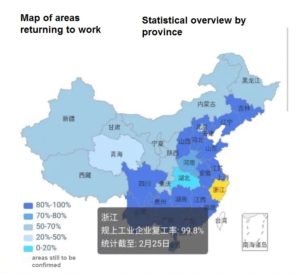At the end of January, China’s provincial and municipal governments initiated the “first level response to major public health emergencies”, implementing travel and trade bans, which indicated the seriousness of the epidemic. For the sake of everyone’s safety, many enterprises have also postponed the resumption of work, in order to block the spread of the disease and restrict traffic. This has undoubtedly affected some domestic enterprises. These measures have also had some impact on business between China and Belgium, and many plans have been put on hold for the time being.
The outbreak first had a big impact on China’s traditional labor-intensive industries but had little impact on new industries such as knowledge- and technology-intensive industries. During the outbreak, the online economy played a huge role. New industries such as intelligent manufacturing and unmanned delivery showed strong growth potential, which further promoted the prosperity of the “Internet + service industry” and promoted the upgrading of the industrial structure. It also partly hedged the negative impact of the outbreak on consumption.
Recently, with the active measures taken by the Chinese government and the cooperation of the people, as well as the material support and donations from all walks of life, the epidemic situation has been effectively controlled, and enterprises of all sizes have begun to return to work. As of March 1, 8 PM, 11 provinces (mainly in the southeastern coastal areas) have seen their industrial enterprises resume work at a rate of more than 90%. This is yet another example of China’s resilience and strength.
| Province | Rate of businesses that returned to work | Date |
| Guizhou | 100% | 26/02/2020 |
| Zhejiang | 99.8% | 25/02/2020 |
| Jiangsu | 99% | 28/02/2020 |
| Shandong | 98% | 27/02/2020 |
| Anhui | 94.8% | 26/02/2020 |
| Shanxi | 93.8% | 28/02/2020 |
| Hunan | 93.5% | 25/02/2020 |
| Sichuan | 92% | 25/02/2020 |
| Jiangxi | 91.6% | 24/02/2020 |
| Guangdong | >90% | 26/02/2020 |
| Liaoning | >90% | 27/02/2020 |
| Fujian | 89.3% | 26/02/2020 |
| Jilin | 87.6% | 25/02/2020 |
| Hebei | 87.4% | 26/02/2020 |
| Shanghai | 87.1% | 24/02/2020 |
| Guangxi | >85% | 27/02/2020 |
| Yunnan | 84% | 27/02/2020 |
| Tianjin | 81.3% | 27/02/2020 |
| Hainan | 73% | 26/02/2020 |
| Henan | 71.8% | 26/02/2020 |
| Shaanxi | Approx. 70% | 26/02/2020 |
| Xinjiang | 68.5% | 26/02/2020 |
| Gansu | 65.3% | 23/02/2020 |
| Neimenggu | 65% | 22/02/2020 |
| Heilongjiang | 64% | 28/02/2020 |
| Beijing | 61.2% | 19/02/2020 |
| Ningxia | 58% | 23/02/2020 |
| Chongqing | >50% | 21/02/2020 |
| Xizang | Approx. 50% | 18/02/2020 |
| Qinghai | 48.5% | 20/02/2020 |
| Hubei | ||
| Hong Kong | Not yet announced | |
| Taiwan | Not yet announced | |
| Macau | Not yet announced |
